Yash Shukla
Autonomous Robotic Assembly: From Part Singulation to Precise Assembly
Jun 11, 2024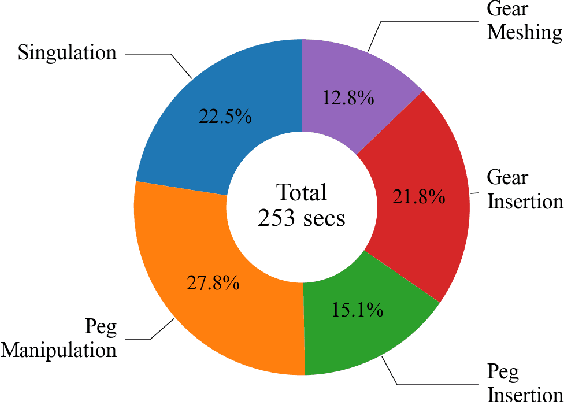
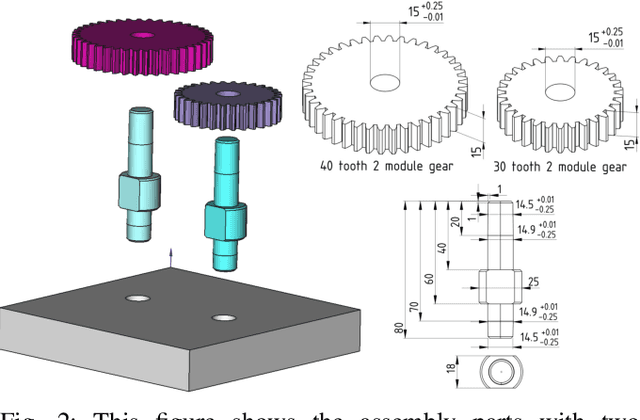


Abstract:Imagine a robot that can assemble a functional product from the individual parts presented in any configuration to the robot. Designing such a robotic system is a complex problem which presents several open challenges. To bypass these challenges, the current generation of assembly systems is built with a lot of system integration effort to provide the structure and precision necessary for assembly. These systems are mostly responsible for part singulation, part kitting, and part detection, which is accomplished by intelligent system design. In this paper, we present autonomous assembly of a gear box with minimum requirements on structure. The assembly parts are randomly placed in a two-dimensional work environment for the robot. The proposed system makes use of several different manipulation skills such as sliding for grasping, in-hand manipulation, and insertion to assemble the gear box. All these tasks are run in a closed-loop fashion using vision, tactile, and Force-Torque (F/T) sensors. We perform extensive hardware experiments to show the robustness of the proposed methods as well as the overall system. See supplementary video at https://www.youtube.com/watch?v=cZ9M1DQ23OI.
Logical Specifications-guided Dynamic Task Sampling for Reinforcement Learning Agents
Feb 08, 2024

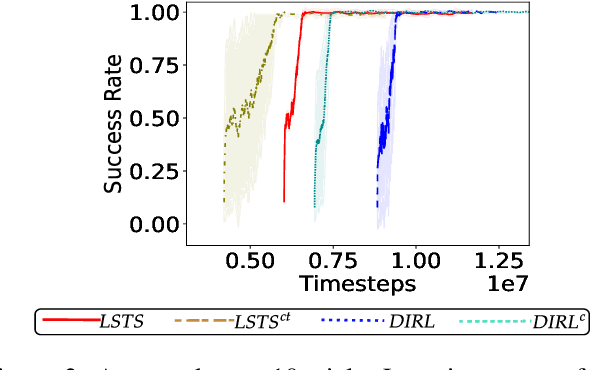

Abstract:Reinforcement Learning (RL) has made significant strides in enabling artificial agents to learn diverse behaviors. However, learning an effective policy often requires a large number of environment interactions. To mitigate sample complexity issues, recent approaches have used high-level task specifications, such as Linear Temporal Logic (LTL$_f$) formulas or Reward Machines (RM), to guide the learning progress of the agent. In this work, we propose a novel approach, called Logical Specifications-guided Dynamic Task Sampling (LSTS), that learns a set of RL policies to guide an agent from an initial state to a goal state based on a high-level task specification, while minimizing the number of environmental interactions. Unlike previous work, LSTS does not assume information about the environment dynamics or the Reward Machine, and dynamically samples promising tasks that lead to successful goal policies. We evaluate LSTS on a gridworld and show that it achieves improved time-to-threshold performance on complex sequential decision-making problems compared to state-of-the-art RM and Automaton-guided RL baselines, such as Q-Learning for Reward Machines and Compositional RL from logical Specifications (DIRL). Moreover, we demonstrate that our method outperforms RM and Automaton-guided RL baselines in terms of sample-efficiency, both in a partially observable robotic task and in a continuous control robotic manipulation task.
LgTS: Dynamic Task Sampling using LLM-generated sub-goals for Reinforcement Learning Agents
Oct 14, 2023



Abstract:Recent advancements in reasoning abilities of Large Language Models (LLM) has promoted their usage in problems that require high-level planning for robots and artificial agents. However, current techniques that utilize LLMs for such planning tasks make certain key assumptions such as, access to datasets that permit finetuning, meticulously engineered prompts that only provide relevant and essential information to the LLM, and most importantly, a deterministic approach to allow execution of the LLM responses either in the form of existing policies or plan operators. In this work, we propose LgTS (LLM-guided Teacher-Student learning), a novel approach that explores the planning abilities of LLMs to provide a graphical representation of the sub-goals to a reinforcement learning (RL) agent that does not have access to the transition dynamics of the environment. The RL agent uses Teacher-Student learning algorithm to learn a set of successful policies for reaching the goal state from the start state while simultaneously minimizing the number of environmental interactions. Unlike previous methods that utilize LLMs, our approach does not assume access to a propreitary or a fine-tuned LLM, nor does it require pre-trained policies that achieve the sub-goals proposed by the LLM. Through experiments on a gridworld based DoorKey domain and a search-and-rescue inspired domain, we show that generating a graphical structure of sub-goals helps in learning policies for the LLM proposed sub-goals and the Teacher-Student learning algorithm minimizes the number of environment interactions when the transition dynamics are unknown.
A Framework for Few-Shot Policy Transfer through Observation Mapping and Behavior Cloning
Oct 13, 2023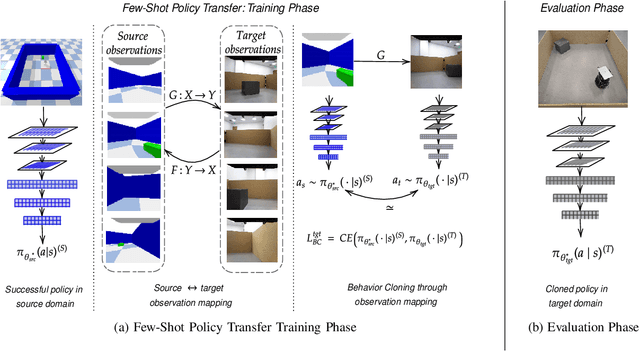
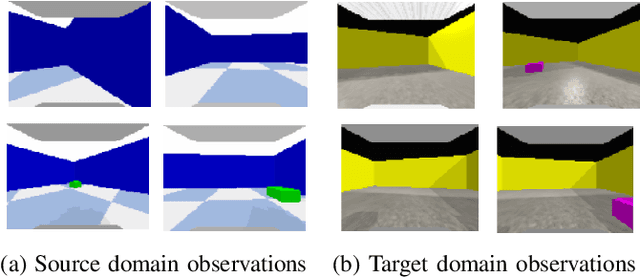
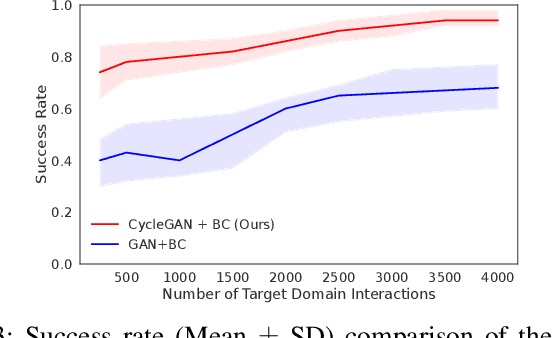
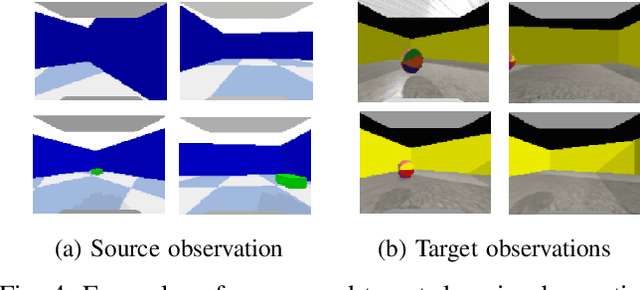
Abstract:Despite recent progress in Reinforcement Learning for robotics applications, many tasks remain prohibitively difficult to solve because of the expensive interaction cost. Transfer learning helps reduce the training time in the target domain by transferring knowledge learned in a source domain. Sim2Real transfer helps transfer knowledge from a simulated robotic domain to a physical target domain. Knowledge transfer reduces the time required to train a task in the physical world, where the cost of interactions is high. However, most existing approaches assume exact correspondence in the task structure and the physical properties of the two domains. This work proposes a framework for Few-Shot Policy Transfer between two domains through Observation Mapping and Behavior Cloning. We use Generative Adversarial Networks (GANs) along with a cycle-consistency loss to map the observations between the source and target domains and later use this learned mapping to clone the successful source task behavior policy to the target domain. We observe successful behavior policy transfer with limited target task interactions and in cases where the source and target task are semantically dissimilar.
Automaton-Guided Curriculum Generation for Reinforcement Learning Agents
Apr 11, 2023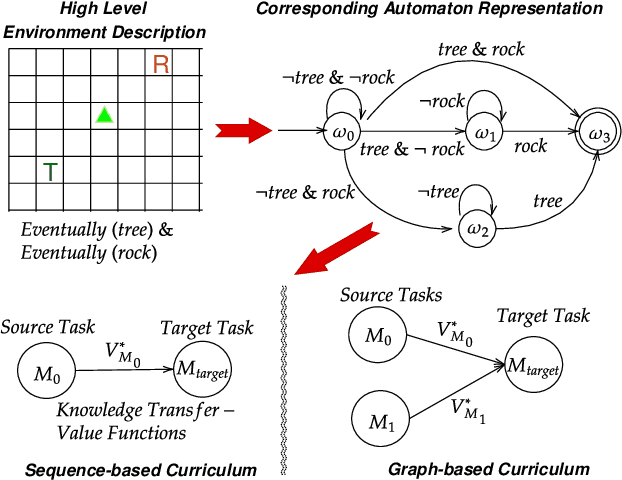


Abstract:Despite advances in Reinforcement Learning, many sequential decision making tasks remain prohibitively expensive and impractical to learn. Recently, approaches that automatically generate reward functions from logical task specifications have been proposed to mitigate this issue; however, they scale poorly on long-horizon tasks (i.e., tasks where the agent needs to perform a series of correct actions to reach the goal state, considering future transitions while choosing an action). Employing a curriculum (a sequence of increasingly complex tasks) further improves the learning speed of the agent by sequencing intermediate tasks suited to the learning capacity of the agent. However, generating curricula from the logical specification still remains an unsolved problem. To this end, we propose AGCL, Automaton-guided Curriculum Learning, a novel method for automatically generating curricula for the target task in the form of Directed Acyclic Graphs (DAGs). AGCL encodes the specification in the form of a deterministic finite automaton (DFA), and then uses the DFA along with the Object-Oriented MDP (OOMDP) representation to generate a curriculum as a DAG, where the vertices correspond to tasks, and edges correspond to the direction of knowledge transfer. Experiments in gridworld and physics-based simulated robotics domains show that the curricula produced by AGCL achieve improved time-to-threshold performance on a complex sequential decision-making problem relative to state-of-the-art curriculum learning (e.g, teacher-student, self-play) and automaton-guided reinforcement learning baselines (e.g, Q-Learning for Reward Machines). Further, we demonstrate that AGCL performs well even in the presence of noise in the task's OOMDP description, and also when distractor objects are present that are not modeled in the logical specification of the tasks' objectives.
RAPid-Learn: A Framework for Learning to Recover for Handling Novelties in Open-World Environments
Jun 24, 2022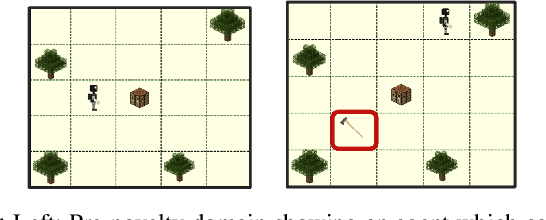



Abstract:We propose RAPid-Learn: Learning to Recover and Plan Again, a hybrid planning and learning method, to tackle the problem of adapting to sudden and unexpected changes in an agent's environment (i.e., novelties). RAPid-Learn is designed to formulate and solve modifications to a task's Markov Decision Process (MDPs) on-the-fly and is capable of exploiting domain knowledge to learn any new dynamics caused by the environmental changes. It is capable of exploiting the domain knowledge to learn action executors which can be further used to resolve execution impasses, leading to a successful plan execution. This novelty information is reflected in its updated domain model. We demonstrate its efficacy by introducing a wide variety of novelties in a gridworld environment inspired by Minecraft, and compare our algorithm with transfer learning baselines from the literature. Our method is (1) effective even in the presence of multiple novelties, (2) more sample efficient than transfer learning RL baselines, and (3) robust to incomplete model information, as opposed to pure symbolic planning approaches.
ACuTE: Automatic Curriculum Transfer from Simple to Complex Environments
Apr 11, 2022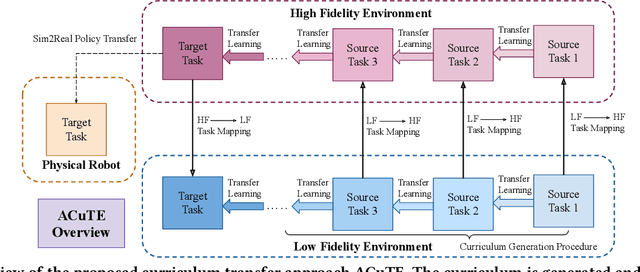
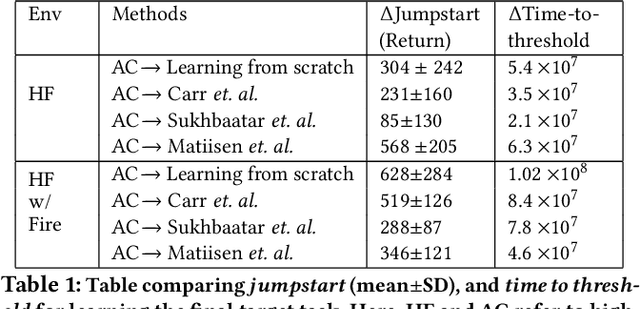


Abstract:Despite recent advances in Reinforcement Learning (RL), many problems, especially real-world tasks, remain prohibitively expensive to learn. To address this issue, several lines of research have explored how tasks, or data samples themselves, can be sequenced into a curriculum to learn a problem that may otherwise be too difficult to learn from scratch. However, generating and optimizing a curriculum in a realistic scenario still requires extensive interactions with the environment. To address this challenge, we formulate the curriculum transfer problem, in which the schema of a curriculum optimized in a simpler, easy-to-solve environment (e.g., a grid world) is transferred to a complex, realistic scenario (e.g., a physics-based robotics simulation or the real world). We present "ACuTE", Automatic Curriculum Transfer from Simple to Complex Environments, a novel framework to solve this problem, and evaluate our proposed method by comparing it to other baseline approaches (e.g., domain adaptation) designed to speed up learning. We observe that our approach produces improved jumpstart and time-to-threshold performance even when adding task elements that further increase the difficulty of the realistic scenario. Finally, we demonstrate that our approach is independent of the learning algorithm used for curriculum generation, and is Sim2Real transferable to a real world scenario using a physical robot.
 Add to Chrome
Add to Chrome Add to Firefox
Add to Firefox Add to Edge
Add to Edge